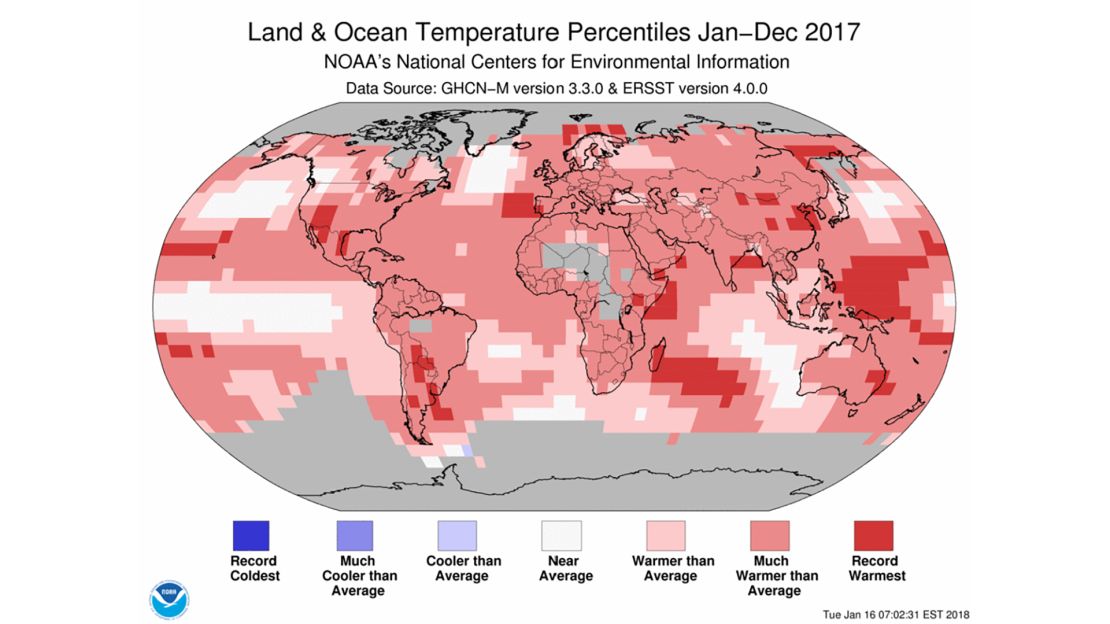Story highlights
2017 was second-hottest on record per NASA
The six hottest years have all been since 2010
2017 was once again one of the hottest years on record, ranked as the second-warmest by NASA and third-warmest by the National Oceanic and Atmospheric Administration.
The findings “continue the planet’s long-term warming trend,” according to NASA. A trend that is driven predominately by human activity through carbon dioxide emissions.
Temperature records for the planet, monitored independently by both agencies, go back to 1880. The announcement came at a joint press conference on Thursday in Washington.
The hottest year on record remains 2016, while 2015 ranks second according to NOAA and third by NASA, which means the top three years have been the most recent three.

Though 2017 was slightly cooler on average compared to 2016. the trend towards a warmer planet has never been clearer.
The six hottest years have all occurred since 2010 and 17 of the 18 hottest years on record have occurred since 2001.
According to NASA, the globally averaged temperature of the land and ocean was 0.9˚C (1.62˚F) above the 20th century average. This puts us well over halfway to the ambitious target of limiting warming to 1.5˚ C (2.7˚F) set in the 2016 Paris Climate Agreement.
Scientists believe if that if we are to avoid exceeding that limit, carbon emissions would need to be significantly reduced starting immediately.
La Niña not enough to cool us down
Scorching heat wave in the West
The slight downturn in temperatures this year can be partially explained by the presence of La Niña, which began in late 2016 and lasted into 2017 and returned late in the year – whereas a robust El Niño was in place during portions of 2015 and 2016.
El Niño is characterized by a warming of the surface waters in the tropical Pacific Ocean – which tends to drive up global temperatures. Therefore years containing El Niños tend to be warmer globally than other years.
La Niñas, on the other hand, feature cooler than average waters in the Pacific, and tend to cool the planet down.
The fact that 2017 was the second- or third-warmest year on record, despite the presence of a cooling La Niña, speaks to the overall warming trend the Earth is experiencing thanks to overall global warming.
According to NASA, if “the effects of the recent El Niño and La Niña patterns were statistically removed from the record, 2017 would have been the warmest year on record.”
Global climate highlights of 2017
Sea ice continued its declining trend, both in the Arctic and Antarctic. The Antarctic, which was trending at record high levels just a few years ago, reached a record low during 2017, with ice covering 154,000 fewer square miles than the previous record low set in 1986.
In the Arctic, sea ice extent was the second-lowest since records began in 1979, behind only 2016, though record low sea ice was observed during the winter months of January-March.
Temperatures significantly warmer than normal around the planet did not mean there was a lack of snow, however. In the northern hemisphere, the average snow cover extent was the largest since 1985 and the eighth largest since records began in 1968, according to Rutgers University’s Global Snow Lab.
2017 also featured a number of extreme weather events, most notably the record number of major hurricanes impacting the US and Caribbean, which led to the costliest year for weather disasters in US history.




















